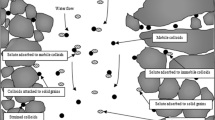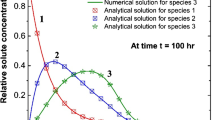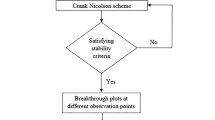Abstract
During the past two decades, significant efforts have been made to study contaminant transport in the presence of colloids. Several researchers reported that colloidal particles could enhance the migration of contaminants in groundwater by reducing retardation factor. When the colloidal particles are present in the aquifer, the subsurface system can be considered as a three-phase system with two solid phases and an aqueous phase. The interaction between contaminants, colloids, and solid matrix should be considered in assessing the fate and transport of the contaminant in the groundwater flow system. In this study, a one-dimensional numerical model is developed by employing a fully implicit finite difference method. This model is based on mass balance equations and mass partition mechanisms between the carriers and solid matrix, as well as between the carriers and contaminants in a saturated homogeneous porous medium. This phenomenon is presented by two approaches: equilibrium approach and fully kinetic first-order approach. The formulation of the model can be simplified by employing equilibrium partitioning of particles. However, contaminant transport can be predicted more accurately in realistic situations by kinetic modeling. To test the sensitivity of the model, the effect of the various chemical and physical coefficients on the migration of contaminant was investigated. The results of numerical modeling matched favorably with experimental data reported in the literature.












Similar content being viewed by others
References
Bekhit, H. M., & Hassan, A. E. (2005). Two-dimensional modeling of contaminant transport in porous media in the presence of colloids. Advances in Water Resources, 28(12), 1320–1335.
McCarthy, J. F., & Zachara, J. M. (1989). Subsurface transport of contaminants. Environmental Science & Technology, 23(5), 496–502.
Sen, T. K., & Khilar, K. C. (2006). Review on subsurface colloids and colloid-associated contaminant transport in saturated porous media. Advances in Colloid and Interface Science, 119(2), 71–96.
Khilar, K.C. and Fogler, H.S. (1998). Migrations of fines in porous media. Vol. 12. Netherlands: Springer. doi:10.1007/978-94-015-9074-7.
Saiers, J. E., & Hornberger, G. M. (1996). The role of colloidal kaolinite in the transport of cesium through laboratory sand columns. Water Resources Research, 32(1), 33–41.
Roy, S. B., & Dzombak, D. A. (1998). Sorption nonequilibrium effects on colloid-enhanced transport of hydrophobic organic compounds in porous media. Journal of Contaminant Hydrology, 30(1), 179–200.
Bhattacharjee, S., Ryan, J. N., & Elimelech, M. (2002). Virus transport in physically and geochemically heterogeneous subsurface porous media. Journal of Contaminant Hydrology, 57(3), 161–187.
Corapcioglu, M. Y., & Jiang, S. (1993). Colloid‐facilitated groundwater contaminant transport. Water Resources Research, 29(7), 2215–2226.
Kan, A. T., & Tomson, M. B. (1990). Ground water transport of hydrophobic organic compounds in the presence of dissolved organic matter. Environmental Toxicology and Chemistry, 9(3), 253–263.
Magee, B. R., Lion, L. W., & Lemley, A. T. (1991). Transport of dissolved organic macromolecules and their effect on the transport of phenanthrene in porous media. Environmental Science & Technology, 25(2), 323–331.
Sirivithayapakorn, S. and Keller, A. (2003). Transport of colloids in saturated porous media: A pore‐scale observation of the size exclusion effect and colloid acceleration. Water Resources Research. doi:10.1029/2002WR001583.
Small, H. (1974). Hydrodynamic chromatography a technique for size analysis of colloidal particles. Journal of Colloid and Interface Science, 48(1), 147–161.
Corapcioglu, M. Y., & Choi, H. (1996). Modeling colloid transport in unsaturated porous media and validation with laboratory column data. Water Resources Research, 32(12), 3437–3449.
Ibaraki, M., & Sudicky, E. (1995). Colloid‐facilitated contaminant transport in discretely fractured porous media: 1. Numerical formulation and sensitivity analysis. Water Resources Research, 31(12), 2945–2960.
Ibaraki, M., & Sudicky, E. (1995). Colloid‐facilitated contaminant transport in discretely fractured porous media: 2. Fracture network examples. Water Resources Research, 31(12), 2961–2969.
Corapcioglu, M. Y., & Wang, S. (1999). Dual‐porosity groundwater contaminant transport in the presence of colloids. Water Resources Research, 35(11), 3261–3273.
Sun, N., et al. (2001). A novel two-dimensional model for colloid transport in physically and geochemically heterogeneous porous media. Journal of Contaminant Hydrology, 49(3), 173–199.
Knabner, P., Totsche, K., & Kögel‐Knabner, I. (1996). The modeling of reactive solute transport with sorption to mobile and immobile sorbents: 1. Experimental evidence and model development. Water Resources Research, 32(6), 1611–1622.
Totsche, K., Knabner, P., & Kögel‐Knabner, L. (1996). The modeling of reactive solute transport with sorption to mobile and immobile sorbents: 2. Model discussion and numerical simulation. Water Resources Research, 32(6), 1623–1634.
Bekhit, H.M. and Hassan, A.E. (2007). Subsurface contaminant transport in the presence of colloids: effect of nonlinear and nonequilibrium interactions. Water Resources Research. doi:10.1029/2006WR005418.
Bekhit, H. M., El-Kordy, M. A., & Hassan, A. E. (2009). Contaminant transport in groundwater in the presence of colloids and bacteria: model development and verification. Journal of Contaminant Hydrology, 108(3), 152–167.
Sen, T. K. (2011). Processes in pathogenic biocolloidal contaminants transport in saturated and unsaturated porous media: a review. Water, Air, & Soil Pollution, 216(1-4), 239–256.
Syngouna, V. I., & Chrysikopoulos, C. V. (2013). Cotransport of clay colloids and viruses in water saturated porous media. Colloids and Surfaces A: Physicochemical and Engineering Aspects, 416, 56–65.
Katzourakis, V. E., & Chrysikopoulos, C. V. (2014). Mathematical modeling of colloid and virus cotransport in porous media: application to experimental data. Advances in Water Resources, 68, 62–73.
Noell, A. L., et al. (1998). The role of silica colloids on facilitated cesium transport through glass bead columns and modeling. Journal of Contaminant Hydrology, 31(1), 23–56.
Author information
Authors and Affiliations
Corresponding author
Rights and permissions
About this article
Cite this article
Kheirabadi, M., Niksokhan, M.H. & Omidvar, B. Colloid-Associated Groundwater Contaminant Transport in Homogeneous Saturated Porous Media: Mathematical and Numerical Modeling. Environ Model Assess 22, 79–90 (2017). https://doi.org/10.1007/s10666-016-9518-2
Received:
Accepted:
Published:
Issue Date:
DOI: https://doi.org/10.1007/s10666-016-9518-2




